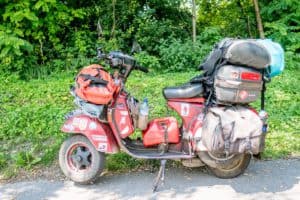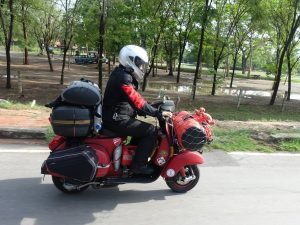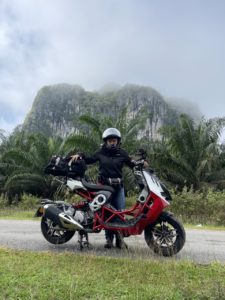Table of Contents
Has my scooter broken down during my 2 years journey from Singapore to Czech Republic? I get asked this a lot.
“Of course!”
Any vehicle, cheap or expensive, new or old, as long as you ride it far and long enough, something is going to wear and tear eventually. We may not be able to prevent breakdowns 100%. If you prepare the motorcycle before a trip, it would reduce the likelihood of breakdowns.
During my 2 years ride from Singapore to the Czech Republic and the recent one around Southeast Asia, I have made mistakes and learnt a lot about the ins and outs of my vehicles.
Keeping a motorcycle in running order is a two-way collaboration between the rider and the mechanic. This blog post is written with perspectives from myself as a rider and founder of Scooter Narcotics, Mark Yeow. He believes that a rider empowered with knowledge will be a satisfied and confident rider.
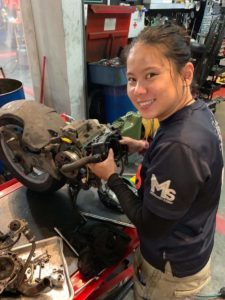
How to prepare a motorcycle for a long ride
Here are some things to check before embarking on a long motorcycle trip.
Tyre
Choose the right tyres for the road condition. Make sure your motorcycle tyres are in good condition and properly inflated. Check the tread depth, and if they are worn out. If the tread is near the Tread Wear Indicator (aligned with the TWI marking on the side of the tyres), replace them before heading out on your trip. Also, make sure that the tires are properly balanced.
Oil
It’s a good idea to change the oil and oil filter before setting off on a long ride. Fresh oil will keep your motorcycle’s engine running smoothly and help prevent breakdowns.
Chain or Belt
Make sure the motorcycle’s chain is clean and well-lubricated and has the correct tension. Loose or tight chains can cause issues while riding and can be dangerous. For Automatic scooter, do check if the belt and rollers need replacement
Battery
Check the battery voltage, terminals, and connections to make sure they’re all in good condition. Charge or replace the battery if necessary.
Lights
Make sure all the lights, including headlights, taillights, and turn signals, are working correctly.
Suspension
Adjust the suspension of your motorcycle to accommodate the extra weight from your luggage.
Fluids
Check the coolant level, transmission fluid, and any other fluids in your motorcycle to ensure they’re at the proper level.
Luggage
Refer to this article for more tips on how to pack for a motorcycle trip.
What are the parts I should replace or service before the long ride?
There are a few deciding factors
- The distance of your ride
- The recommended replacement interval as stated in the user manual
- The servicing history of your motorcycle
If you are going on a 400 km return trip from Singapore to Malaysia, it may not be necessary to do a valve check that is due every 20,000km. But if you are going to ride for an extended distance that overlaps the periodic maintenance, it may be good to get them done before setting off. Knowing the servicing history will help you identify parts that need to be replaced or not. You wouldn’t want to be wasting money changing out parts prematurely and unnecessarily too.
Should I upgrade motorcycle parts for long distance trip?
There are a few question to ask yourself. What is the purpose of getting the performance parts? Is it for more power? Is it for durability? Bear in mind that you can’t have power and durability concurrently. More power means higher revolution per minute from the engine. That also means higher rate of wear and tear.
I would usually prefer to maintain stock set up for my rides mainly because after-market parts may not be easily available in other countries. However, sometimes, after-market parts can outlast original parts which makes them worthy investments.
What are the spare parts I should bring on a motorcycle trip?
As much as we would like to carry many parts for a sense of security, it is not practical to be carrying all the spare parts, adding extra load on the motorcycle. The spares to bring are unique for each vehicle. Here are some guiding questions to help you decide what to bring.
What are the weak points of your vehicle?
Bring spares for the weak points. If you have ridden your vehicle long enough, you would have known what are the parts that breaks often. If you are new to the vehicle, you can research forums and ask experienced owners to find out the common issue with your chosen vehicle.
Is it too bulky to carry with you?
Nuts, cables, fuses and spark plugs are light and easy to carry around. Part is something heavier and bulky, you may want to consider shipping it to you when required. I carried a spare piston and cylinder given to me from Thailand to Pakistan. That was no fun! I was so happy to get rid of it when there was a chance.
Is it available in the countries you are travelling?
If the vehicle is widely used in the countries you are travelling to, there are high chances you can find part supplies. If you know that some regions do not carry the parts for your vehicles, it will be good to stock up before entering these zones.
It is good to preplan what are the parts you will need along the way and check if workshops along your route stock the parts. If they do not stock the parts, you may wish to get them shipped to these workshops in advance.
E.g. Some of the parts I carry specifically for the Vespa GT200
- Belt
- Waterpump repair kit
- Fuses
- Headlamp
- Hose clips
There are general supplies and tools I recommend carrying for minor and temporary fixes.
- Tyre repair kit
- Jumpstart
- Coolant
- Duct tape
- Cable Ties
- Rok Straps or other luggage straps
What should I regularly check during a long ride
Mark Yeow breaks down the things to check frequently into 3 elements – Water, Fire, Air.
Water (Coolant)
The temperature sensor reveals the coolant radiator’s health. If you find your engine overheating quickly, it is time to check your coolant reservoir for the level, any possible leakage or air pocket (which can happen after a coolant flush).
Fire (Electricity)
Most modern motorcycle these days comes with an electric starter. Ensure that the battery is 12.8-14.V range. Having a voltmeter will help you to monitor it easily, and prevent run ins with dead batteries and a dead motorcycle.
Air (Tyre)
Ensure that your tyres are properly inflated. A portable air pump and air pressure gauge come very handy here.
What mechanical skills should I learn for a long distance motorcycle trip?
You don’t need to be a fully competant mechanic before you start a motorcycle road trip. At the very least, the following skills will come very useful during the trip.
Fixing a punctured tyre
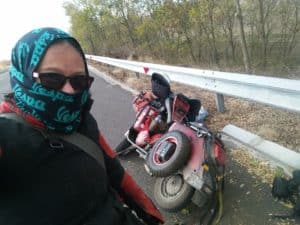
Are you running on tube or tubeless tyres? Punctured tubeless tyre are very easy to patch with plugs. If you are on tube tyres, always bring a spare inner tube and the tools to remove the wheel. Don’t forget an air pump
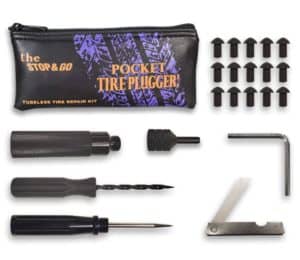
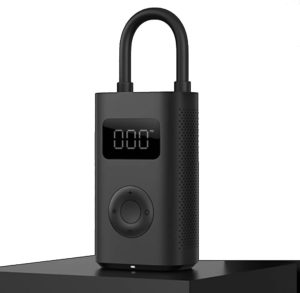
Jumpstarting a dead motorcycle
Jumpstarter holds charge for limited number of try. Do not waste them. Before attempting to jumpstart your motorcycle, eliminate other causes first (e.g. ignition switch, side stand sensor, connector issue). Having a voltmeter is helpful to determine if the battery is really dead.
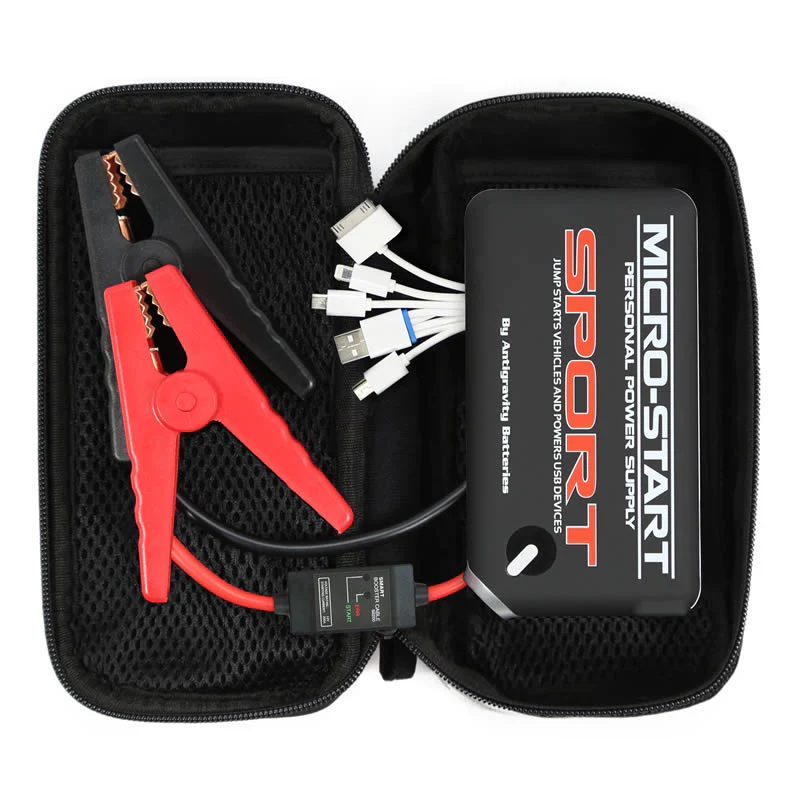
Checking and topping up coolant
The owner manual should have the instructions on how to do this. A torch light will come in handy to check the level.
Checking and changing fuse
Short circuit can cause electrical issues like the motorcycle not starting or lights not working. Once you are able to locate and access the fuse box, change fuse is easy peasy.
What do to if my motorcycle breaks down?
First, it is very important to stay calm.
1. Move to a safe location
If possible, try to move your motorcycle off the road to a safe location where you can work on it without risking your safety. If you can’t move your motorcycle, make sure you put your hazard lights on and stay as far to the side of the road as possible.
2. Assess the problem
Once you are in a safe location, assess the problem to try and determine what’s wrong with your motorcycle. If you are unsure, look up the owner’s manual, google search or call your mechanic.
3. Try to fix the problem
If you have the tools and knowledge to fix the problem, try to do so. If not, you may need to call for roadside assistance, a tow truck, or use a GPS tracker (e.g. Spot Tracker) to alert someone of your location.
4. Stay visible
While you are waiting for assistance, make sure you are visible to other drivers by putting on your hazard lights and wearing reflective clothing if you have it.
5. Be patient
Finally, be patient and stay calm while you wait for help to arrive. Don’t try to fix the problem if you don’t have the necessary tools or knowledge, as this could make the situation worse.
Overlanders’ Mindset on Mechanics
Besides the technical aspect of motorcycle preparation, it is also important to address the attitude and mindset towards it.
Sense of ownership
Ultimately, you are the one riding after all.
One of the mistakes that I made in my 2015 trip was over-reliance on mechanics for servicing and diagnosis of any problems with the scooter. If you are just using the vehicle in town, you will likely be visiting one trusted mechanic However, while overlanding, you would likely be visiting different mechanics in different countries.
Each mechanic would not know the servicing history of your vehicle. You are the only constant with your vehicle. Therefore, it is your duty to keep a record of the servicing history. Many times, knowing the history can help to diagnose mechanical issues more easily. Try to be present whenever the vehicle is worked on and take the time to learn more about it too.
If you are serious about learning to do it yourself, you may grab a copy of Haynes Owners Workshop Manual for your motorcycle. These manuals come with comprehensive instructions and photos on maintenance and repairs for automobiles. YouTube has a lot of videos that teaches you how to do simple servicing to. You can also get in touch with your trusted mechanic to seek advice.
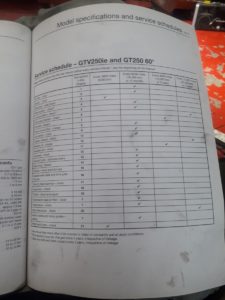
If you are totally new, taking charge of your vehicle’s maintenance schedule is the first step out of mechanical ignorance. As Mark has advised, it is important to refer to the periodic maintenance service schedule in the vehicle owner’s manual. Periodic maintenance and checks will likely pick up worn vehicle parts for replacement before a breakdown happens.
Here is a Vehicle Service Log template that I use to track and log maintenance schedule.
Communication with Mechanic
The following information will be useful for the mechanic to better decide what needs to be done or not be done:
- Distance if your trip
- Time Duration
- Road conditions (highway, off-road, mountainous)
- Environmental conditions (Temperature, altitude)
- Past servicing history should be relayed to the mechanics.
Ask questions if you are unsure. If the mechanic is dismissive or shady about what needs to be done, maybe it is better to look for another mechanic.
Don’t trust mechanics 100% (even those from authorised workshops)
As the rider of your vehicle, you know your vehicle better like how the engine normally sounds, and how the vehicle usually handles. Even if the mechanic tells you there is no problem but you feel that something is unusual, insist on checking. Ask them for permission to watch and learn while they service.
After every servicing, do check that all the nuts and bolts are tightened and not overtightened.
In my latest journey riding Southeast Asia, I was a bit complacent at an authorised Vespa workshop in Cambodia. My oil cap was not tightened after servicing. That mistake led to an engine overhaul.
Authorised is not an endorsement for reliability. I later learnt about the reputation of local authorised workshops in Cambodia from local bikers. It is best to get workshop recommendation from local biking community.
Embrace Breakdowns
In the beginning, I was a mechanical idiot who knew little. It was quite nerve-racking when my vehicle broke down for the first time in a foreign land. Each time something goes wrong, it is an opportunity to learn. Once you learn to deal with an issue, you gain the confidence to deal with it again. Soon enough, you will begin to regard breakdowns not as a fear, but accept them as part and parcel of overlanding.
I hope you find this post helping
About Scooter Narcotics

Scooter Narcotics is bornt out of the passion for scooter tuning and racing. A satisfying ride is the shared responsibility of the mechanic and rider. Scooter Narcotics is committed not just to providing services to scooter owners but also empowering them with knowledge of their own ride. Follow their social media and learn what goes on within the scooter as they share their work log.
Special thank to Mark Yeow of Scooter Narcotic for mechanical and parts support throughout this current Southeast Asia Tour.



